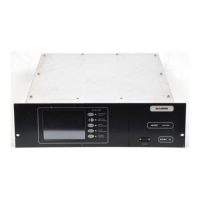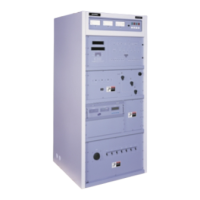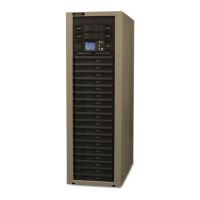3.3.13. Overload Adjustment Procedures
3.3.13.1. Power Supply Current Overload
Check the present Power Supply Current
reading against the value on the factory test
data sheet for the same operating condi-
tions. If the present reading is significantly
higher, it will be advisable to investigate the
cause before proceeding with the following
overload adjustment.
The overload threshold can be set to the
same value as recorded on the factory test
data sheet, or by checking the trip threshold
by modulating it with a tone according to
the following procedure.
Forsetting theoverloadundermodulating
conditions, operate the transmitter at 110%
of its rated power output (5500 watts for
GATES FIVE, 2750 watts for a GATES
TWO, and 1100 watts for a GATES ONE).
Modulate with 20 Hz to 100%. Increase
the audio level 0.5dB (6%).
Adjust R11 on the Controller board coun-
terclockwise until the transmitter faults,
then 1/3 of a turn clockwise from this trip
point.
3.3.13.2. Underdrive Fault
Note:The UnderdriveFaultthresholdvar-
ies directly with the PDM Level such that
the minimum drive requirements are less
stringent at low power levels, but require
fullRFDriveatfullpower.
The indicated RF Drive level should al-
waysbesomewhat abovethethreshold(Un-
derdrive Set) in a normal condition.
With the actual RF Drive having been
verified on the PA module(s), the RF Drive
reading is adjusted so that it reads suffi-
ciently above the Underdrive Set reading at
full power.
Verifying the correct RF drive amplitude
(26-32 Vpp) requires checking the PA in-
puts with a scope. Measure across R13,
R14, R23, R24, R33, R34, R43 and R44 for
each PA module. For the procedure on
checking the drive on the PA module(s),
refer to Section C.
After verifying the actual RF drive to be
in the normal range, modulate the transmit-
ter to 100% with 400 Hz at 110% power
output (5500 watts for GATES FIVE, 2750
watts for a GATES TWO, and 1100 watts
for a GATES ONE).
Adjust R143 on the Controller board
counterclockwise until the transmitter steps
to the next lower power level and displays
the Underdrive fault. Then rotate R143
clockwise from the trip point about 2 turns.
3.3.13.3. VSWR Detector
You may set the VSWR trip threshold
using the value recorded on the factory test
data sheets, or may use a more involved
process which actually causes the overload
circuit to operate.
With the transmitter on, and NO modula-
tion applied, set the LOW power control all
the way to zero power output.
Use a clip lead to short across R18 on the
Output Monitor board. This will cause the
VSWR detector to not be nulled when you
bringupRFpower.
Gradually increase the power output, and
watch the VSWR Detector Null reading
come up from zero.Adjust R14 on theCon-
troller board so that the transmitter trips off
when the VSWR Detector Null reading
reaches 7.5 on the Multimeter.
3.4. Replacing Boards and
Replacing Board Components
The following boards may be replaced or
have componentsreplacedwithout theneed
for adjustments or measurements:
Interface Board
PDM Pull Up boards
PDM Filter board
IPA Power Splitter board
PA Toroid boards
The remainder of the boards have adjust-
ments or frequency determined compo-
nents. Refer to section on particular board
that is being replaced for information on
checkout procedures to follow.
NOTE
When board replacement is required,
caution must be exercised in tightening
both current carrying and non-current
carrying surfaces. Non-current carrying
tightness should be only a snug fit (i.e.
PA module heat sink); while current car-
rying tightness should be more secure
than snug but not over tightened. Re-
member that relatively fragile printed
circuit board surfaces are being tight-
ened and damage to boards can occur if
excessive torque is applied.
3-6 888-2314-001 Rev. AD
WARNING: Disconnect primary power prior to servicing.
